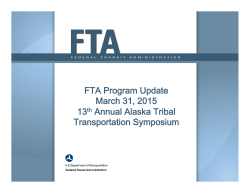
bus transit industry - Operations Research and Financial Engineering
Application of Autonomous Collision Avoidance Technology to Transit Buses to Reduce Claims, Injuries and Fatalities In the three year period 2011 to 2013, New Jersey Transit reported paying out $43 million in bus casualty and liability expenses. During that period, NJ TRANSIT buses were involved in 258 collisions, caused 937 injuries, and 10 fatalities. automated collision avoidance technology to reduce claims, injuries, and fatalities. The proposal team included leading experts in transit technology, the American Public Transportation Association, the Greater Cleveland Regional Transit Authority and the Washington State Transit Insurance Pool. Attached to the proposal were letters of support from transit insurance pools representing 75 transit agencies in four states. Recent NJ TRANSIT settlements: $10 million: Angelique Marlene Delaney Baker vs. Jean Dalme and NJ Transit Angelique Marlene Delaney Baker fell underneath the bus, which crushed her arm, legs and pelvis. She suffered serious injuries that require ongoing care. The proposed project included four phases spanning three years and budgeted at $6.2 million, with $5 million sought in FTA funding and $1.2 from local match. FTA did not select the proposal for funding last year, due to budget limitations, but has indicated that the proposal is strong and has gained support in the agency and the industry. $6.5 million: Elba Galeno vs. NJ Transit, et al. Elba Galeno was struck by a bus in a crosswalk, which then backed up and trapped her. She claimed she suffered serious injuries to both legs, and eventually her right leg was amputated from the knee down. Congressional support is needed to advance this life-saving technology. $4.5 million: June Layne vs. NJ Transit, et al. June Layne was trapped under the bus' rear wheels and suffered extensive leg injuries. She was hospitalized for three months and convalesced another two months at a nursing facility. She suffered permanent injuries and will need ongoing care. Key contacts for the proposal team are: Dr. Alain L. Kornhauser, Professor of Operations Research and Financial Engineering, Princeton University, alaink@princeton.edu Dr. Jerome M. Lutin, Senior Director, Statewide and Regional Planning, NJ TRANSIT (Retired) jerome.lutin@verizon.net In 2013, nationwide, the transit bus industry reported 4,075 collisions, 15,351 injuries, 119 fatalities, and $499 million in casualty and liability expenses. We can prevent many of these injuries and fatalities and reduce claims expenses Mr. Louis F. Sanders, Director, Technical Services, American Public Transportation Association lsanders@apta.com Princeton University has submitted a proposal to the Federal Transit Administration (FTA) that would apply Mr. Jerry Spears, Deputy Director, Washington State Transit Insurance Pool jerry@wstip.org 1 Summary of Proposed Research instrumentation and an autonomous collision avoidance simulator and will provide technician assistance, garage space, and participate in testing. Phase 1 will establish an effective project management structure and create an industry-wide stakeholder group including representatives of transit agencies, risk management and insurance providers, consultants, vehicle manufacturers, systems developers, standards organizations, vendors, motor vehicle regulators, and USDOT officials. Volunteers from the stakeholder group will be asked to participate in expert technical working groups (ETWG’s) to assist in the development and balloting of consensus standards for autonomous collision avoidance technology for transit buses. These standards will make it possible to install life-saving advanced technology on new transit buses and to retrofit exiting buses. Urgency Each month, approximately ten people die, more than 1,200 are injured in bus crashes and over $41 million in casualty and liability expenses are reported. Under FTA rules, buses acquired with Federal funds are expected to last 12 years, although buses can typically remain in service for 15 to 18 years. Action is needed now to insure that life-saving technology will be available to the industry. Return on Investment The entire research plan is designed to develop products that will allow new technology, autonomous collision avoidance systems for buses, to be developed quickly and safely in an environment that will encourage competition and innovation. It will develop functional requirements, standards and specifications that will meet the needs of transit operators. The project will then develop test protocols, a simulator, data logger, and on-board test bed that will be used to allow vendors to have their products tested and certified. In Phase 2 the project team will conduct a research assessment of why casualty and liability claims are increasing. The team will then determine the potential for automated collision avoidance systems to reduce fatalities, injuries, and claims. Phase 3 will develop functional requirements and standards to allow installation of collision avoidance and driver assist technology on new transit buses and retrofit of existing buses. The proposal team has already documented that bus collisions have contributed to a $4.1 billion drain on the transit industry for casualty and liability claims over a ten year period. The total budget for this project, at $6.3 million, represents less than five daysworth, or 1.2% of the $499 million in casualty and liability claims that the industry reported in 2013 alone. It is a small price to pay for a project that has such an enormous target potential. Phase 4 will develop a prototype test bed that would allow developers of innovative collision avoidance and driver assist technologies to work with transit agencies and researchers to expedite development and deployment. Greater Cleveland Regional Transit Authority (GCRTA) will host development of the prototype testbed. GCRTA will provide two buses that would be retrofitted to allow installation of 2
© Copyright 2025










